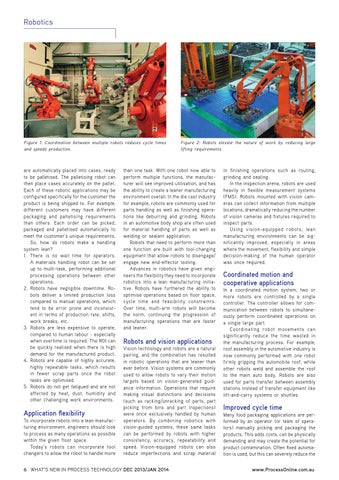Robotics
Figure 1: Coordination between multiple robots reduces cycle times and speeds production.
are automatically placed into cases, ready to be palletised. The palletising robot can then place cases accurately on the pallet. Each of these robotic applications may be configured specifically for the customer the product is being shipped to. For example, different customers may have different packaging and palletising requirements than others. Each order can be picked, packaged and palletised automatically to meet the customer’s unique requirements. So, how do robots make a handling system lean? 1. There is no wait time for operators. A materials handling robot can be set up to multi-task, performing additional processing operations between other operations. 2. Robots have negligible downtime. Robots deliver a limited production loss compared to manual operations, which tend to be error prone and inconsistent in terms of production rate, shifts, work breaks, etc. 3. Robots are less expensive to operate, compared to human labour - especially when overtime is required. The ROI can be quickly realised when there is high demand for the manufactured product. 4. Robots are capable of highly accurate, highly repeatable tasks, which results in fewer scrap parts once the robot tasks are optimised. 5. Robots do not get fatigued and are not affected by heat, dust, humidity and other challenging work environments.
Application flexibility To incorporate robots into a lean manufacturing environment, engineers should look to process as many operations as possible within the given floor space. Today’s robots can incorporate tool changers to allow the robot to handle more
Figure 2: Robots elevate the nature of work by reducing large lifting requirements.
than one task. With one robot now able to perform multiple functions, the manufacturer will see improved utilisation, and has the ability to create a leaner manufacturing environment overall. In the die cast industry for example, robots are commonly used for parts handling as well as finishing operations like deburring and grinding. Robots in an automotive body shop are often used for material handling of parts as well as welding or sealant application. Robots that need to perform more than one function are built with tool-changing equipment that allow robots to disengage/ engage new end-effector tooling. Advances in robotics have given engineers the flexibility they need to incorporate robotics into a lean manufacturing initiative. Robots have furthered the ability to optimise operations based on floor space, cycle time and feasibility constraints. Over time, multi-arm robots will become the norm, continuing the progression of manufacturing operations that are faster and leaner.
Robots and vision applications Vision technology and robots are a natural pairing, and the combination has resulted in robotic operations that are leaner than ever before. Vision systems are commonly used to allow robots to vary their motion targets based on vision-generated guidance information. Operations that require making visual distinctions and decisions (such as racking/unracking of parts, part picking from bins and part inspections) were once exclusively handled by human operators. By combining robotics with vision-guided systems, these same tasks can be performed by robots with higher consistency, accuracy, repeatability and speed. Vision-equipped robots can also reduce imperfections and scrap material
6 WHAT'S NEW IN PROCESS TECHNOLOGY DEC 2013/JAN 2014
in finishing operations such as routing, grinding and sealing. In the inspection arena, robots are used heavily in flexible measurement systems (FMS). Robots mounted with vision cameras can collect information from multiple locations, dramatically reducing the number of vision cameras and fixtures required to inspect parts. Using vision-equipped robots, lean manufacturing environments can be significantly improved, especially in areas where the movement, flexibility and simple decision-making of the human operator was once required.
Coordinated motion and cooperative applications In a coordinated motion system, two or more robots are controlled by a single controller. The controller allows for communication between robots to simultaneously perform coordinated operations on a single large part. Coordinating robot movements can significantly reduce the time wasted in the manufacturing process. For example, roof assembly in the automotive industry is now commonly performed with one robot firmly gripping the automobile roof, while other robots weld and assemble the roof to the main auto body. Robots are also used for parts transfer between assembly stations instead of transfer equipment like lift-and-carry systems or shuttles.
Improved cycle time Many food packaging applications are performed by an operator (or team of operators) manually picking and packaging the products. This adds costs, can be physically demanding and may create the potential for product contamination. Often fixed automation is used, but this can severely reduce the
www.ProcessOnline.com.au
